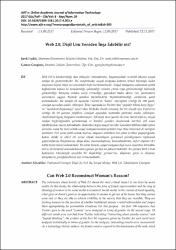| dc.contributor.author | Işıklı, Şevki | |
| dc.contributor.author | Gezginci, Gamze | |
| dc.date.accessioned | 2019-01-28T07:52:13Z | |
| dc.date.available | 2019-01-28T07:52:13Z | |
| dc.date.issued | 2017-11-12 | |
| dc.identifier.issn | 1309-1581 | |
| dc.identifier.uri | http://hdl.handle.net/11363/1012 | |
| dc.description.abstract | Web 2.0’ın karakteristiği olan etkileşim (interaktivite), hayatımızdaki en kritik etkisini sosyal medya ile göstermektedir. Bu araştırmada; sosyal medyada kadının temsil biçimiyle kadın düşünme biçimi (dişil us) arasındaki ilişki incelenmektedir. Sosyal medyanın; toplumsal eşitlik bağlamında kadına ne kazandırdığı, çıkamadığı evinden çıkma veya görünemediği toplumda görünürlüğe kavuşma imkânı verip vermediği, geleneksel kadın aklını (us) postmodern durumlara uygun biçimde yeniden biçimlendirip biçimlendirmediği sorularına yanıt aranmaktadır. Bu amaçla ilk aşamada Twitter’ın “kadın” sözcüğüne verdiği ilk 100 yanıt, cinsiyet açısından analiz edilmiştir. İkinci aşamada ise Twitter’dan “popüler bilime karşı ilgiyi” ve “mantıksal düşünmeyi” işaret eden 18 farklı sözcük aranmış; her bir sözcük için Twitter’ın verdiği ilk 50 yanıtın profilleri, cinsiyet açısından istatistiki yöntemle analiz edilmiştir. Analizlerde ilginç bulgulara rastlanmıştır: Teknoloji okur-yazarı bir özne olarak dişil us, sosyal medya özgürlüğünden yararlanmak ve kendini yeniden oluşturmak isterken eril usun tahakkümüne maruz kalmaktadır. Kadınla erkeğin sosyal normlar açısından hâlihazırdaki eşitsiz durumu, ussal bir özne olarak sosyal medyada kendini yeniden inşa etme sürecinde de varlığını sürdürür. Eril ustan farklı olarak dişil us, rasyonel nitelikleri öne çıkan içerikler paylaştığında, kadını ahlaki ve ailevi bir nesne olarak tanımlayan geleneksel paradigmanın toplumsal yaptırımlarına (küçümseme, alaya alma, önemsizleştirme, konumlandırma, nefret söylemi vb.) hatta tacize maruz kalmaktadır. Bu nihai durum, sosyal medyada dişil usun cesaretini kırmakta, eril us ile teknoloji arasında kurulan egemen görüşü ise pekiştirmektedir. Bu yüzden Web 2.0 da kadınların teknolojiyle karşılıklı bir diyalektiğe girmelerine, düşünme gücü ve düşünce dünyalarını genişletmelerine izin vermemektedir. | en_US |
| dc.description.abstract | The interaction characteristic of Web 2.0 shows the most critical impact in our lives by social media. In this study; the relationship between the form of female representation and the way of thinking of women in the social media is examined. Social media; In the context of social equality, what gives or doesn’t gives as an opportunity to woman to get out of the house that they cannot come out, or they are able to achieve visibility in the society that they are invisible, They are Seeking answers to the question of whether traditional women's mind reformulates and shapes them appropriately for postmodern situations For this purpose the first 100 responses that Twitter gave to the word "woman" were analyzed in terms of gender. In the second stage, 18 different words were searched from Twitter indicating "interesting about popular science" and "logical thinking"; the profiles of the first 50 responses given by Twitter for each word were analyzed statistically in terms of gender. In the analyzes, interesting results were encountered: As a technology literate subject, the female mind is exposed to the domination of the male mind while seeking to take advantage of social media freedom and to rebuild herself In terms of social norms, the current unequal status of women continues to exist in the process of rebuilding themselves in the social media. Unlike the male mind, women are exposed to the social sanctions of the traditional paradigm, which defines women as a moral and family object when they share intelligent, rational qualities, even torture (contempt, derogation, positioning, hate speech, etc.). This ultimate situation breaks the courage of the female mind in the social media and consolidates the dominant view established between male intelligence and technology. That's why the web. 2.0 do not allow women to interact into a mutual dialectic with technology and man’s reason doesn’t let to expand their power of thinking and power of world. | en_US |
| dc.language.iso | tur | en_US |
| dc.publisher | AJIT-e: Online Academic Journal of Information Technology | en_US |
| dc.relation.isversionof | 10.5824/1309-1581.2017.4.003.x | en_US |
| dc.rights | info:eu-repo/semantics/openAccess | en_US |
| dc.rights | Attribution-NonCommercial-NoDerivs 3.0 United States | * |
| dc.rights.uri | http://creativecommons.org/licenses/by-nc-nd/3.0/us/ | * |
| dc.subject | Research Subject Categories::TECHNOLOGY | en_US |
| dc.title | Web 2.0, Dişil Usu Yeniden İnşa Edebilir mi? | en_US |
| dc.title.alternative | Can Web 2.0 Reconstruct Woman’s Reason? | en_US |
| dc.type | article | en_US |
| dc.relation.ispartof | AJIT-e: Online Academic Journal of Information Technology | en_US |
| dc.department | İstanbul Gelişim Üniversitesi | en_US |
| dc.identifier.volume | 8 | en_US |
| dc.identifier.issue | 29 | en_US |
| dc.identifier.startpage | 53 | en_US |
| dc.identifier.endpage | 74 | en_US |
| dc.relation.publicationcategory | Kategori Yok | en_US |



















